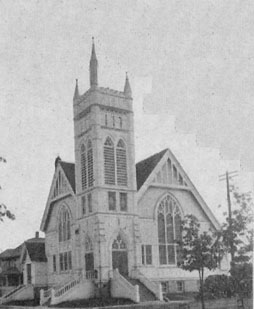

"In the late 1840’s, missionaries of two branches of the Presbyterian faith—the Associate and the Associate Reformed—arrived in the Willamette Valley. In July, 1850, Dr. T. S. Kendall organized the Associate Presbyterian Church in the Oakville neighborhood, and this is still a strong rural church. In 1851, Wilson Blain arrived in the valley. He had lived in Oregon City and had been editor of the “Oregon Spectator.” He organized a church at Union Point, near Brownsville, Oregon. Other missionaries followed.
"The difficulties of travel and the great distances from church centers soon caused the question of union to come up, resulting in a compact being drawn up uniting these bodies into the United Presbyterian Church of Oregon. Taking part in the Union were Dr. Kendall, Dr. Irvine, and Rev. J. P. MilIar of the associate group. In the Associate Reformed group were Rev. Blain, Rev. James Worth, and Rev. Jeremiah Dick. This union took place at the home of Rev. Blain, October 20, 1852. These two bodies united in Pittsburgh into the United Presbyterian Church of North America in 1858.
"In October, 1853, the Albany Church was organized, the first to be organized as the United Presbyterian Church. The Rev. J. P. Millar was pastor until his death in April, 1854. He was killed by an explosion of the Steamship “Gazelle” near Oregon City.
"Dr. Irvine, who was pastor at Oakville (Willamette), followed the Rev. Millar, by giving part time to the Albany Congregation until 1873. He severed his connection with the Willamette Church, moving to Albany, where he was pastor until his death in 1895. He was Moderator of the General Assembly in 1878.
"The Albany congregation met in the Courthouse, an octagonal building which burned in the 1860’s. A church was built in 1863 at Fifth and Washington, on ground obtained from Thomas Montieth. This building served many years, but on June 20, 1891, the cornerstone of the present church was laid and the church formally dedicated, August 7, 1892.
"The General Assembly met in Albany in 1894, and Dr. Irvine was able to attend one meeting in a wheelchair. The next pastor to remain many years was Dr. W. P. White. He came in the fall of 1901, and was pastor until 1920. In 1906, the Dr. S. G. Irvine Memorial pipe organ was installed at a cost of over $2,800....
"Again the General Assembly met in Albany in 1952, with commissioners from all over the United States and the mission fields. In 1953, the church observed the “100th Anniversary” of the organizing of the church. The contractor for building the church was J. B. Cougill; it cost about $16,500. The architect, who drew the plans for the present church, was Walter Pugh, of the firm of McCauley and Wickersham of Salem. The name “White Spires” was made official on January 8, 1958.
"The spires are outstanding and are the highest points in Albany. The supports are made of laminated wood. Though swaying badly during the typhoon of October 12, 1962, it stood, although traffic was blocked off for hours. The stained-glass windows were not broken. They are very unusual both in design and coloring. The White Spires Church still stands and the present pastor [1963] is the Rev. Ralph R. Hawthorne."
Text Excerpt from "Oregon Historic Landmarks", Oregon Society DAR (4)
![]()
"Whitespires is a fine example of Gothic Revival, designed by the well-known architect, Walter Pugh. The 85' high tower has been a city landmark since 1892, with its four points reaching into the sky like the fingers of an uplifted hand. A fifth spire is on the adjoining rooftop. Whitespires' unique features include a two-ton bell cast in Troy NY 1865; stained glass windows by the renowned Povey Family of Portland and the 1906 Kimball pipe organ. Noteworthy is the wood paneling of the interior and the curving wooden pews.
"With roots in Calvinistic Scotland, the United Presbyterians brought their faith to the Willamette Valley, uniting the Associate and Associate Reformed branches in 1852. The first U. P. Church organized in the U. S. was in Albany in 1853 by Rev. James P. Miller. The first building was small, located at Fifth and Washington replaced in 1892 by the present church. These were devout, psalm-singing Presbyterians, "lining-out" their songs without any musical instrument in the early days. Later a reed organ was introduced, replaced by the present pipe organ. Dr. S. G. Irvine, pastor 1855-1894, was a community leader of distinction who also taught at Albany College.
"The Albany church was nationally recognized for its leadership and for hosting the General Assembly in 1894 and again in 1952. After the merger of the Presbyterians U.S.A. with the United Presbyterians, the two local churches began working together and merged in1967. It was impossible to maintain two buildings so later the Whitespires Church building was sold."
Text excerpt from Remembering When II -- A Photo Collection of Historic Albany, Oregon, by Robert Potts (7).
Photo from the collection of Lisa L. Jones.